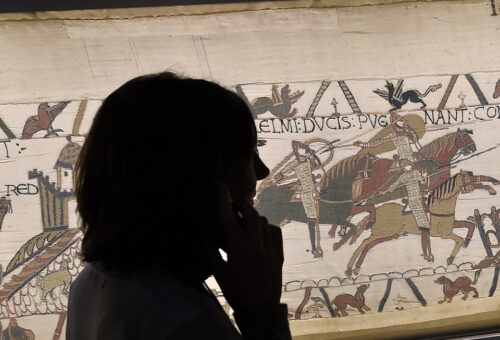Will the future for the exhibition of the Bayeux Tapestry look like the Grotte de Lascaux? With access to the authentic tapestry closed off for the wider public?
 One of the great “medieval” experiences is to see and study the authentic Bayeux Tapestry in Normandy. Unfortunately, however, the present critical condition demands urgent restoration at the cost of more than €2 mill. Also, the scientific committee has decided that “only restoration operations of the Bayeux Tapestry will be able to justify its movement” from the present exhibition, probably preventing the promise of the loan of the Tapestry to London in 2024, when the museum at Bayeux is scheduled to be renovated. The plan is to have the museum reopen in 2026 after a facelift. The present exhibition opened in 1983.
One of the great “medieval” experiences is to see and study the authentic Bayeux Tapestry in Normandy. Unfortunately, however, the present critical condition demands urgent restoration at the cost of more than €2 mill. Also, the scientific committee has decided that “only restoration operations of the Bayeux Tapestry will be able to justify its movement” from the present exhibition, probably preventing the promise of the loan of the Tapestry to London in 2024, when the museum at Bayeux is scheduled to be renovated. The plan is to have the museum reopen in 2026 after a facelift. The present exhibition opened in 1983.
The renovation project is intended both to enhance the way the public is introduced to the work and, above all, to improve its conservation and the way it is presented, we are informed. Work on the project is being directed by the City of Bayeux and the decentralised services of the French Ministry of Culture (DRAC Normandie), with the support of the Calvados General Council and the Normandy Regional Council. It is the fruit of collegial, interdisciplinary and international deliberations by a scientific committee bringing together experts in conservation-restoration, archaeologists, historians and art historians.
One of the questions raised will be the lighting applied in the exhibition. The current fashion is to dim most medieval textile shows. Likely, the curators and scientists responsible for the precious heirloom will argue for – at best – a seriously dimmed presentation. At worst, the Tapestry will only be on show for select times and small groups, as is the case for visitors to the grottos with cave paintings. Perhaps, in the future, the view of the recently created high-definition photo series will be all most people can get access to?
A recent digitisation project carried out under the auspices of the City of Bayeux, The DRAD Normandie, the University of Caen, CNRS and the ENSICAEN describes the project as intended “to reinforce the accessibility of the Tapestry”.
The Digitisation Process

Whatever the future brings, the recently developed digital tool is state of the art. This project involved a spatialised documentary information system inspired by a classic geographical information system but adapted to the scale of the embroidery. This tool allows for the management of documentary and scientific information about the work, geo-referenced to a high-definition representation of the Tapestry. The realisation of this project involves finding answers to several questions, such as the production of images for the tool, obtained from a series of digital photographs creating a panorama measuring a total of 480,000 x 6,000 pixels and consisting of 86 high-resolution and multi-spectral images. Another part of the project covers a 3D reconstruction currently underway.
“These tools also have the advantage of increasing the possibilities in terms of cultural mediation and offering interactive ways to involve the public in the discovery process, making them more active in their approach to knowledge”, Writes the authors and continue: “For instance, the construction of a 2D panorama in daylight, may already serve as a background image for any indexing or information system, hence solving the geo-referencing problem. Lastly, the high-resolution 3D-reconstruction of the Tapestry will allow both to virtually visualise the Tapestry in augmented reality applications and to realise faithful 3D-printed mockups, which may be touched without damaging the original artwork”, we are told in a recent presentation of the project. Also, one of the qualities of this part of the project is to allow visually-impaired people to access the tapestry and get a feel for it.
Perhaps, the future will not be as dim as prognosticated. However, the history of the preservation of fragile textiles tells us it is close to a miracle that the Tapestry still exists. And the solution – to create a faithful 3-D mockup as was done at Lascaux – is perhaps under consideration.
SOURCE:
Image Processing for Cultural Heritage Accessibility:
Digitizing the Bayeux Tapestry
By Matthieu Pizenberg, Abderrahim Elmoataz, Yvain Quéau
